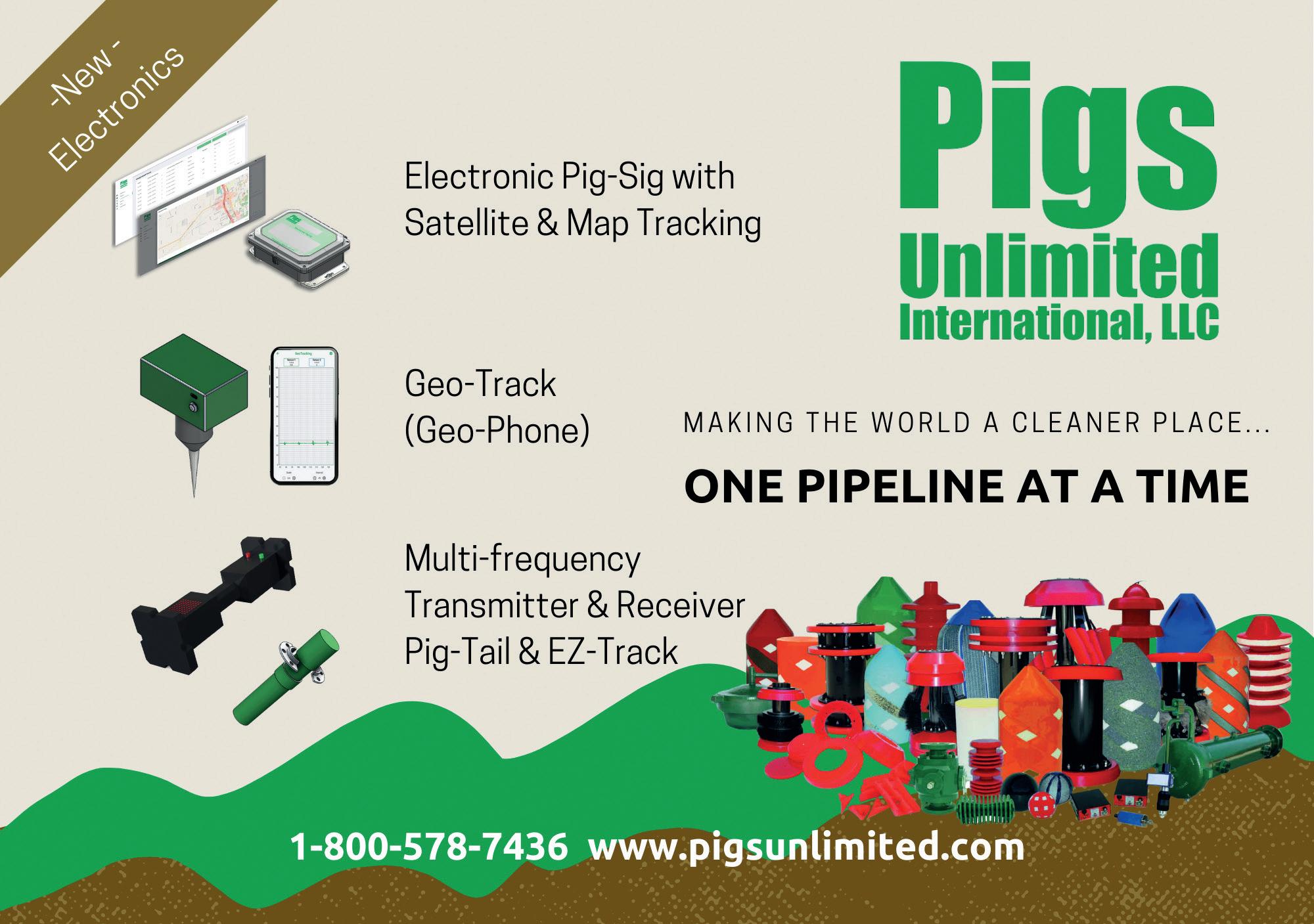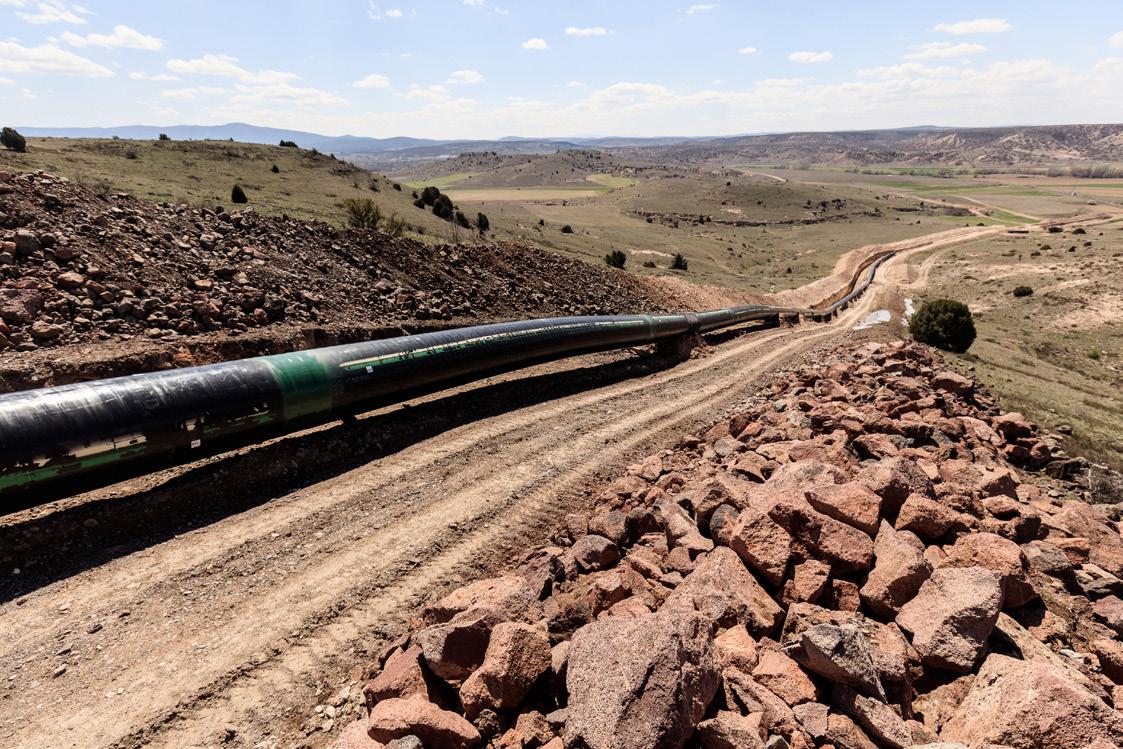
13 minute read
Improving the security of pipelines
having to deal with uneven, rocky terrain while working. With COVID-19 also here to stay for the foreseeable future, 24/7 medical support, case management, and security services are all essential considerations for pipeline companies going forward.
Managing dangerous and challenging worksites From the dry, hot deserts to cold rainy mountains, Remote Medical International (RMI) provides medical and safety support staff to varied and challenging remote worksites worldwide. Placing medical and safety staff to provide both primary and emergency medical care, RMI has a team of over 200 highly qualified and experienced medics operating in varied high risk and challenging locations, meaning it is well-placed to service the pipeline industry to meet the increasingly demanding health and safety needs of the trade.
In mountainous regions where workers are operating at altitude, against steep inclines in unpredictable weather conditions, often with heavy equipment, the pressure on teams is such that it can become extremely difficult to ensure that health and safety measures are diligently obeyed. Rapidly changing weather conditions can create the perfect environment for slips and falls on slippery and uneven surfaces due to condensation and rain, while cold weather presents its own unique challenges with the potential for frostbite to set in as soon as 30 minutes without proper clothing. Since certain articles of clothing, such as hoods, are not allowed to be worn on pipeline projects due to safety hazards, cold weather makes the work even more dangerous.
In environments where weather conditions can change hour by hour and day by day on any given project, adequate planning and preparation against these safety hazards can be a challenge for team leaders. This is where having an onsite medic can add real value, as accident prevention through training and education can mean teams operate with greater efficiency and with a far reduced potential for common accidents, which cause delays to project timelines and add strain to budgets. For example, strains and sprains are extremely common for employees in remote locations, especially if they are working on vertical and rugged terrain. RMI onsite medics deliver training and education on best practice for equipment use that can help teams manage working on slopes, or with managing temperature changes to help prevent injury.
While accident prevention is a key aspect of providing exceptional health and safety protection for pipeline workers, in the unfortunate event that accidents do happen, accessibility to the site is another issue having an onsite medic can mitigate. Often, transporting a patient from a pipeline team to an offsite medic will result in losing crucial time to navigating the terrain. This can create its own problems and present greater risk to not only the patient, but also the team operating at the site and the continuity of the project itself. During one project supported by RMI, a worker received a minor head injury. Historically, the patient would have needed to be taken to a local clinic, however, since our remote paramedic was able to evaluate the patient onsite, the wound was treated with butterfly closures, and the operator was able to return to work within 45 minutes. Such rapid response means that workers can return to work as quickly and safely as possible, without the need for costly transfers to hospitals.
Contracted short-term employees pose higher risk With high demand of work, and low supply of workers, pipeline construction projects operate on a tight schedule and often rely on short service employees, or independent workers, to quickly fulfill jobs to keep projects running on time. However, for short-term employees, experience with heavy equipment can be limited; equipment that can pose a serious safety threat when not properly manned. Combined with the remote and dangerous environments, short service employees are at higher risk of injuring themselves, and potentially putting others in harm’s way. Hand and eye injuries are the most common, and our onsite RMI medics help to lessen these risks by educating workers on the importance of wearing the appropriate personal protective equipment (PPE) to help prevent unnecessary injuries.
Pipeline project in Texas RMI has been working on a large pipeline project in Texas, delivering medical support for its 2200-strong workforce since 2009.
As the project is an extensive one. RMI’s support involvement in the multi-million-dollar project provides a highly-experienced team consisting of occupational health physicians, onsite paramedics, and multiple emergency medical technicians to ensure the onsite workforce is healthy and immediately supported in any medical emergency.
As the location of the project moves, RMI medics are deployed to set up and outfit multiple onsite clinics for the workforce, including a field-transportable clinic for use on a remote island, and two mobile treatment centres (MTC). These four-wheel drive clinics allow our medical staff to provide treatment in the types of remote environments standard emergency vehicles are unable to reach. In addition to a treatment area, storage and hand washing facilities, the MTC is equipped with first aid supplies and emergency response equipment, including an automated external defibrillator, trauma management equipment, and a backboard and litter for patient transport, meaning that our onsite medics are well prepared to respond to any type of medical emergency, no matter where the pipeline project is situated or how remote or challenging the location.
Keeping construction sites going during COVID Establishing safe working conditions and providing onsite expert medical care has always been of paramount importance but, now, effective COVID-19 management plans have also become essential in creating safe working environments and, importantly, in keeping them operational should personnel contract COVID-19. In these circumstances, controlling the spread of infection is mission critical for ensuring the continuity of projects.
Early on in the pandemic, we learned that many symptoms presented by an individual had the potential to be COVID-19. We used this knowledge to respond to our clients’ needs to get employees back to work safely, as quickly as possible. RMI’s medical experts have helped numerous pipeline construction companies to deliver COVID-19 screening and treatment programmes that are tailored to their current needs. As the pandemic continues and with undoubtedly more variants to come, we have seen an increase in demand for COVID-19 testing services, in particular across pipeline sites. PCR tests, with results issued within 24 hours, and rapid onsite testing, both allow employers to see test results quickly. When used appropriately, faster results can mean speedier decisionmaking, a smoother running of operations and reduced risk for everyone overall.
Since emergency response is a core component of our services for pipeline construction sites, all our medics are trained to either a basic or high level in emergency medical service skills. In addition to this, they are trained and experienced in medicine specific to industrial work, such as primary care training and occupational health and safety awareness training. This additional level of knowledge enables our providers to supplement the skillset of the project’s existing workforce – very often our medics are the only medical provider on a smaller project, but sometimes they act as an integral component to a more robust medical programme on larger pipeline projects. By interacting regularly and building trusted relationships with the construction workers, onsite medics become a highly-valued member of the team, ensuring that if injuries or illnesses do occur, workers readily seek medical support. Enabling this swift communication and response is essential to prevent some of the potentially lifethreatening injuries sustained on pipeline construction sites.
Summary No matter how remote the location, RMI can deliver critical support in vital and diverse ways. One of our recent operations has seen us manage not only onsite support and first-line medical response, but also fit for duty testing for prospective pipeline workers, and project pre-evaluation, including hazard evaluation and medical emergency response plans. Alongside crucial ongoing work behind the scenes, like respirator fit testing, it is this type of integrated support which has enabled companies to continue running operations smoothly in often adverse circumstances.
With the unique set of safety challenges offered by pipeline sites, it is essential to have remote and trustworthy medical support from professionals onsite. Not only can this improve the safety of the workforce, but can also reduce unnecessary transfers to faraway medical services. At RMI our health and safety professionals know how to look out for these injuries and ensure the health and safety of workers thanks to their expertise in the field. By prioritising the wellbeing of the workforce, organisations will benefit from improved productivity across projects which can, in turn, help to unlock long-term profitability.
Pedro Barbosa, Product Owner, Fotech, highlights the threat of oil theft and considers the latest security measures to best protect pipelines.

The price of oil has been fluctuating during 1Q22, but the overall trend is rising, and is forecast to be an average US$105.22/bbl this year compared to US$70.89/bbl in 2021.1 Theft of fuel increasingly becomes an issue with high prices as organised crime targets pipelines and it is a serious and significant threat worldwide. According to a report by Ernst & Young, US$133 billion worth of crude oil and refined products are stolen or adulterated every year. An average of 3299 bbls of oil were being stolen per day in Colombia in 2021 and Nigeria was estimated to have lost as much as US$4 billion, about 10% of the country’s foreign reserves, to oil theft.2,3
Not only does theft result in significant monetary losses to oil and gas companies, but also botched theft attempts can pose serious safety risks to pipelines’ personnel, not to mention the environmental consequences. For example, a now infamous pipeline explosion in Tlahuelilpan, Mexico, left 137 dead and dozens injured in 2019. It is understood that the pipeline rupture was caused by thieves looking to profit from stolen fuel.4
In extreme, remote locations that are difficult to access, criminals believe they can seize their opportunity more easily. They believe their theft attempts will go unnoticed or they will have more time to evade security. It’s clear to see that a robust pipeline security strategy, coupled with cutting edge detection technology, is vital to preventing theft and protecting assets.
Taking security seriously
Product is typically stolen through hot tapping, where criminals target pipelines to extract oil.
The appeal is high since offenders can readily steal hundreds of thousands of dollars in just a few minutes. Fuel thieves are often extremely professional and typically aware of periodic surveillance activities. In less remote locations, in a bid to evade security teams, criminals tend to remain hidden and steal smaller amounts at the time. Other times they tap a pipeline once and steal as much as they can, and don’t return. In these situations, it is possible that leaks progress undetected over time, or even worse, those tap locations can become a threat to pipeline integrity, potentially failing with all the consequences associated with that. Criminals are also wise to placing illegal taps close to the usual fittings, thinking that operators will believe the tap is a genuine fixing. Additionally, they are aware that internal leak detection systems can be deceived by slow siphon rates that may have been made by the smallest of drills.
Reacting quickly and accurately
Having the ability to detect when and where an incident takes place on the pipeline is critical to being able to stop a theft attempt. The faster access to that information, the better. Establishing the exact location of the tap is a challenge using traditional technologies, especially when pipelines stretch for hundreds of kilometres across all terrains. For example, systems using traditional mass balance methods are reliable for detecting loss of bigger quantities of product but cannot give detailed information about the location. Location accuracies are as high as a few hundred meters. Even if a leak is detected,

it can still take days before operators realise where the tapping operation was performed.
Right-of-way surveillance by operators can also give a slow response. Pipelines might pass through forest, desert or icy tundra, so travelling by road or by foot may take several hours or more.
A deeper look at DAS Distributed Acoustic Sensing (DAS) is proving itself as a robust and reliable technology that improves the security of pipelines because it is exceptionally difficult for criminals to evade. Using photonics, DAS technology essentially turns a fibre optic cable running alongside a pipeline network into thousands of vibration sensors, able to detect any disturbances along the length of the pipeline. As it is hidden, thieves are unaware of its presence.
The technology sends thousands of pulses of light along the fibre optic cable every second and monitors the fine pattern of light reflected back. When acoustic or vibrational energy – such as that created by digging near a pipeline or fitting a hot tap – creates a strain on the optical fibre, this changes the reflected light pattern. By using advanced algorithms and processing techniques, DAS analyses these changes to identify and to categorise any disturbance. Each type of disturbance has its own signature and the technology can tell an operator, in realtime, what happened, exactly where it happened and when it happened.
DAS can also pinpoint the location, fast, and in realtime. This highly reliable technology can cover ranges of up to 100 km. With vital information about an incident being delivered to the operator within even seconds of it taking place, in practical terms this means that notification of an incident can be given before a single barrel of product has been stolen.
The intelligent DAS technology can adapt the system’s response depending on whether an incident occurs in a high or low risk zone, while accommodating shift patterns and areas where authorised activity may be taking place. This avoids the inconvenience of
‘false alarms’, and the time and cost associated with investigating them. Instead, in the event of an incident, pipeline operators can take appropriate action rapidly, with all the necessary information having been made immediately available to them.
Integrating DAS and UAV technology Indeed, the best approach to a security strategy is one which doesn’t rely on a single technology but uses a range of complementing technologies that work with each other seamlessly to give a detailed picture of the pipeline. DAS should be part of a foundational security strategy. It is easily integrated into existing security systems, working in conjunction with cameras, sentry posts and unmanned aerial vehicles (UAVs) – or drones – to provide situational awareness and to enhance overall protection.
The rapid advancement of drone technology, introduces new possibilities, including the automatic threat-response launch and flight of a UAV to GPS coordinates provided by DAS. The flight path is automatically set using the flight management system, which can take into account the topology and obstacles, the endurance of the battery and the weather conditions. The UAV, which is kept on standby, automatically takes off and flies to the designated coordinates. There is no need for an operator to be present on site, as the flight can be monitored from an operations room either at the pipeline operator’s security centre, or at the UAV service provider.
With the right strategy, a UAV can reach a location along a pipeline in the required target response time, providing footage from visual and thermal cameras. This could prove critical in extreme locations that are difficult to access. Even at night, a UAV can make its presence known to criminals with high-powdered LED

Figure 1. Establishing the exact location of a tap is a challenge using traditional technologies, especially when pipelines stretch for hundreds of kilometres across all terrains.
Figure 2. A DAS monitoring system with integrated UAV technology creates a powerful detection and response system.







